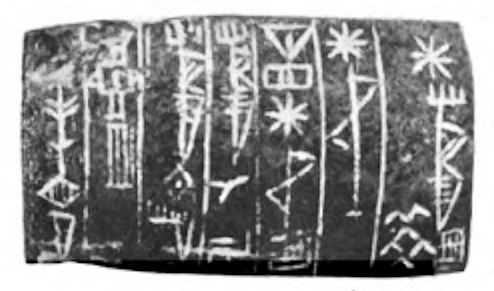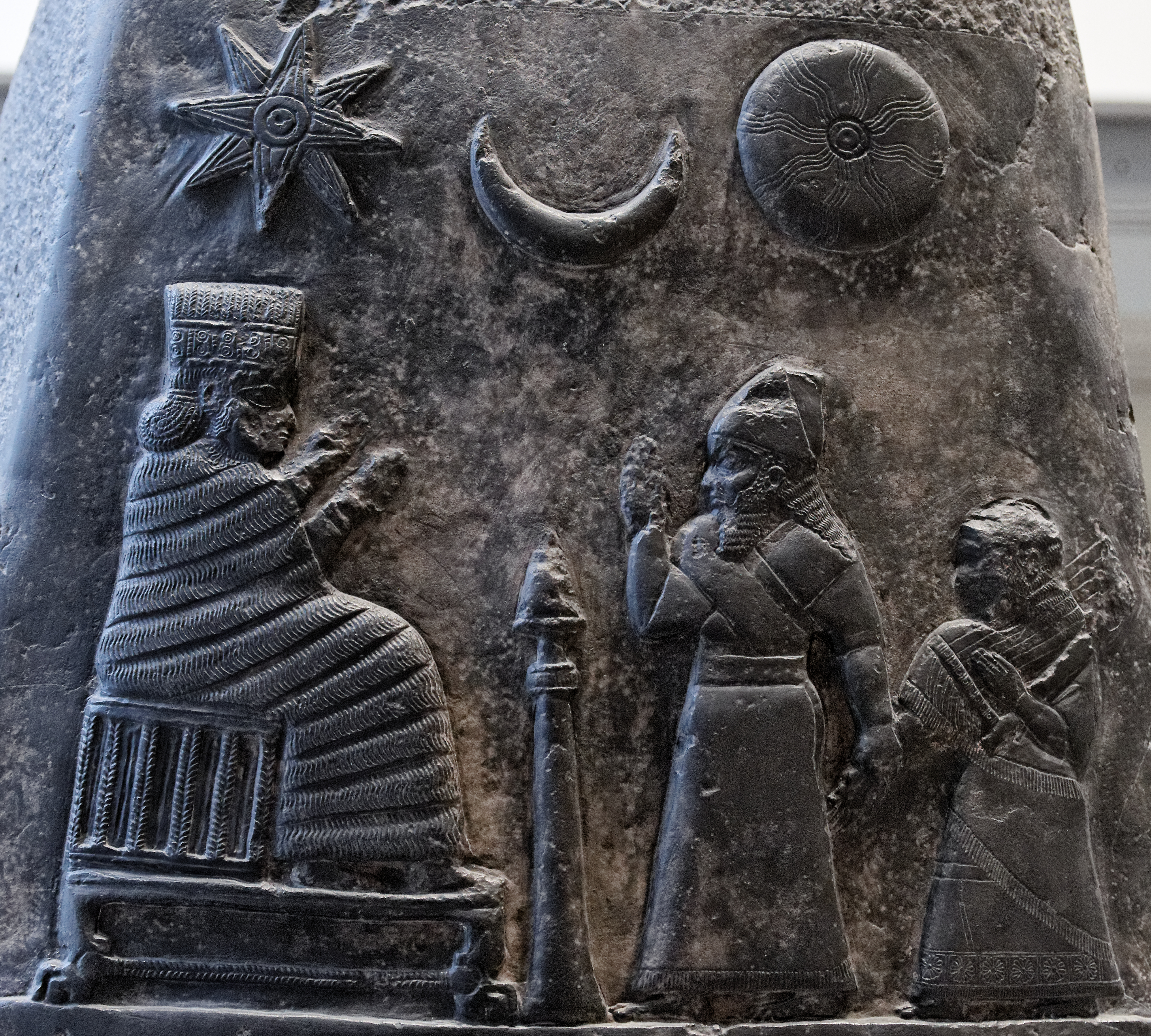|
Ninshubur
Ninshubur (,; Ninšubur, "Lady of Subartu" or "Lady of servants"), also spelled Ninšubura, was a Mesopotamian goddess regarded as the ''sukkal'' (divine attendant) of the goddess Inanna. While it is agreed that in this context Ninshubur was regarded as female, in other cases the deity was considered male, possibly due to syncretism with other divine messengers, such as Ilabrat. No certain information about her genealogy is present in any known sources, and she was typically regarded as unmarried. As a ''sukkal'', she functioned both as a messenger deity and as an intercessor between other members of the pantheon and human petitioners. Due to the belief that she could intercede with higher ranking deities, Ninshubur was popular in everyday religion, and many theophoric names invoking her and other references to personal worship are known. Her original cult center was Akkil, but in the Early Dynastic Period (Mesopotamia), Early Dynastic Period she was already worshiped in nearby Ur ... [...More Info...] [...Related Items...] OR: [Wikipedia] [Google] [Baidu] |
Sukkal
Sukkal (conventionally translated from Sumerian as "vizier") was a term which could denote both a type of official and a class of deities in ancient Mesopotamia. The historical sukkals were responsible for overseeing the execution of various commands of the kings and acted as diplomatic envoys and translators for foreign dignitaries. The deities referred to as sukkals fulfilled a similar role in mythology, acting as servants, advisors and envoys of the main gods of the Mesopotamian pantheon, such as Enlil or Inanna. The best known sukkal is the goddess Ninshubur. In art, they were depicted carrying staves, most likely understood as their attribute. They could function as intercessory deities, believed to mediate between worshipers and the major gods. The office sukkal is also known from various areas to the west and east of Mesopotamia, including the Hurrian kingdom Arrapha, Syrian Alalakh and Mari and Elam under the rule of the Sukkalmah Dynasty, while the concept of divin ... [...More Info...] [...Related Items...] OR: [Wikipedia] [Google] [Baidu] |
Papsukkal
Papsukkal () was a Mesopotamian god regarded as the sukkal (attendant deity) of Anu and his wife Antu in Seleucid Uruk. In earlier periods he was instead associated with Zababa. He acquired his new role through syncretism with Ninshubur. Character Papsukkal was originally the sukkal (attendant and messenger deity) of Zababa, the tutelary god of Kish. His name is a combination of the Sumerian words ''pap'', "older brother," and sukkal. Papsukkal's eventual rise to prominence at the expense of other similar figures, such as Ninshubur, as well as Kakka and Ilabrat, was likely rooted simply in the presence of the word sukkal in his name. In the context of the so-called "antiquarian theology" relying largely on god lists, which developed in Uruk under Achaemenid and Seleucid rule, he was fully identified with Ninshubur and thus became Anu's sukkal and one of the eighteen major deities of the city. In the Seleucid period he was regarded as the sukkal of both Anu and Antu ... [...More Info...] [...Related Items...] OR: [Wikipedia] [Google] [Baidu] |
Inanna
Inanna is the List of Mesopotamian deities, ancient Mesopotamian goddess of war, love, and fertility. She is also associated with political power, divine law, sensuality, and procreation. Originally worshipped in Sumer, she was known by the Akkadian Empire, Akkadians, Babylonian religion, Babylonians, and Assyrians as Ishtar. Her primary title is Queen of Heaven (antiquity), "the Queen of Heaven". She was the patron goddess of the Eanna temple at the city of Uruk, her early main religious center. In archaic Uruk, she was worshipped in three forms: morning Inanna (Inana-UD/hud), evening Inanna (Inanna sig), and princely Inanna (Inanna NUN), the former two reflecting the phases of her associated planet Venus. Her most prominent symbols include the Lion of Babylon, lion and the Star of Ishtar, eight-pointed star. Her husband is the god Dumuzid (later known as Tammuz), and her (attendant) is the goddess Ninshubur, later conflated with the male deities Ilabrat and Papsukkal. Inanna ... [...More Info...] [...Related Items...] OR: [Wikipedia] [Google] [Baidu] |
Mesopotamian Goddess
Deities in ancient Mesopotamia were almost exclusively Anthropomorphism, anthropomorphic. They were thought to possess extraordinary powers and were often envisioned as being of tremendous physical size. The deities typically wore ''melam'', an ambiguous substance which "covered them in terrifying splendor" and which could also be worn by heroes, kings, giants, and even demons. The effect that seeing a deity's ''melam'' has on a human is described as ''ni'', a word for the "Paresthesia, physical creeping of the flesh". Both the Sumerian language, Sumerian and Akkadian languages contain many words to express the sensation of ''ni'', including the word ''puluhtu'', meaning "fear". Deities were almost always depicted wearing horned caps, consisting of up to seven superimposed pairs of ox-horns. They were also sometimes depicted wearing clothes with elaborate decorative gold and silver ornaments sewn into them. The ancient Mesopotamians believed that their deities lived in Heaven, ... [...More Info...] [...Related Items...] OR: [Wikipedia] [Google] [Baidu] |
Ilabrat
Ilabrat was a Mesopotamian god who in some cases was regarded as the ''sukkal'' (attendant deity) of the sky god Anu. Evidence from the Old Assyrian period indicates that he could also be worshiped as an independent deity. Name Multiple etymologies have been proposed for Ilabrat's name, including "god of (the land/city) Iabrat" (suggested by Ignace Gelb) and "tutelary god of the simple people"(suggested by Thorkild Jacobsen), but none are universally accepted, and it is not certain that it came from a Semitic language as presumed in these two proposals. Some late lexical lists connect the element -''labr'' with the Sumerian word ''labar'', "servant", treated as a synonym of ''sukkal'' in this context, which lead Frans Wiggermann to propose that Ilabrat's name was Sumerian in origin, and that the hypothetical older form of the name might have been Nin-labrat. In most cases due to Akkadian grammar it is possible to determine with certainty that Ilabrat was considered a male deit ... [...More Info...] [...Related Items...] OR: [Wikipedia] [Google] [Baidu] |
Nergal
Nergal ( Sumerian: d''KIŠ.UNU'' or ; ; Aramaic: ܢܸܪܓܲܠ; ) was a Mesopotamian god worshiped through all periods of Mesopotamian history, from Early Dynastic to Neo-Babylonian times, with a few attestations indicating that his cult survived into the period of Achaemenid domination. He was primarily associated with war, death, and disease, and has been described as the "god of inflicted death". He reigned over Kur, the Mesopotamian underworld, depending on the myth either on behalf of his parents Enlil and Ninlil, or in later periods as a result of his marriage with the goddess Ereshkigal. Originally either Mammitum, a goddess possibly connected to frost, or Laṣ, sometimes assumed to be a minor medicine goddess, were regarded as his wife, though other traditions existed, too. His primary cult center was Kutha, located in the north of historical Babylonia. His main temple bore the ceremonial name E-Meslam and he was also known by the name Meslamtaea, "he who comes ... [...More Info...] [...Related Items...] OR: [Wikipedia] [Google] [Baidu] |
Enki
Enki ( ) is the Sumerian god of water, knowledge ('' gestú''), crafts (''gašam''), and creation (''nudimmud''), and one of the Anunnaki. He was later known as Ea () or Ae p. 324, note 27. in Akkadian (Assyrian-Babylonian) religion, and is identified by some scholars with Ia in Canaanite religion. The name was rendered Aos within Greek sources (e.g. Damascius). He was originally the patron god of the city of Eridu, but later the influence of his cult spread throughout Mesopotamia and to the Canaanites, Hittites and Hurrians. He was associated with the southern band of constellations called ''stars of Ea'', but also with the constellation AŠ-IKU, ''the Field'' ( Square of Pegasus). Beginning around the second millennium BCE, he was sometimes referred to in writing by the numeric ideogram for "40", occasionally referred to as his "sacred number". The planet Mercury, associated with Babylonian '' Nabu'' (the son of Marduk) was, in Sumerian times, identified with En ... [...More Info...] [...Related Items...] OR: [Wikipedia] [Google] [Baidu] |
Sin (mythology)
Sin () or Suen (, ) also known as Nanna ( ) is the Mesopotamian god representing the moon. While these two names originate in two different languages, respectively Akkadian language, Akkadian and Sumerian language, Sumerian, they were already used interchangeably to refer to one deity in the Early Dynastic Period (Mesopotamia), Early Dynastic period. They were sometimes combined into the double name Nanna-Suen. A third well attested name is Dilimbabbar (). Additionally, the name of the moon god could be represented by logograms reflecting his lunar character, such as d30 (), referring to days in the lunar month or dU4.SAKAR (), derived from a term referring to the crescent. In addition to his astral role, Sin was also closely associated with cattle herding. Furthermore, there is some evidence that he could serve as a judge of the dead in the Ancient Mesopotamian underworld, underworld. A distinct tradition in which he was regarded either as a god of equal status as the usual hea ... [...More Info...] [...Related Items...] OR: [Wikipedia] [Google] [Baidu] |
Adab (city)
Adab (Sumerian language, Sumerian: ''Adab''ki, spelled UD.NUNKI) was an ancient Sumerian city between Girsu and Nippur, lying about 35 kilometers southeast of the latter. It was located at the site of modern Bismaya or Bismya in the Al-Qādisiyyah Governorate of Iraq. The site was occupied at least as early as the 3rd Millenium BC, through the Early Dynastic, Akkadian Empire, and Ur III empire periods, into the Kassite dynasty, Kassite period in the mid-2nd millennium BC. It is known that there were temples of Ninhursag, Ninhursag/Digirmah, Iskur, Asgi, Inanna and Enki at Adab and that the city-god of Adab was Parag'ellilegarra (Panigingarra) "The Sovereign Appointed by Ellil". Not to be confused with the small, later (Old Babylonian and Sassanian periods) archaeological site named Tell Bismaya, 9 kilometers east of the confluence of the Diyala and the Tigris rivers, excavated by Iraqi archaeologists in the 1980s or Dur-Kurigalzu#Tell_Basmaya, Tell Basmaya, southeast of mode ... [...More Info...] [...Related Items...] OR: [Wikipedia] [Google] [Baidu] |
Gallu
In Sumerian and ancient Mesopotamian religion, gallûs (also called gallas; Akkadian ''gallû'' < Sumerian ) were s or s of the . Role in mythology Gallu demons hauled unfortunate victims off to the . They were one of seven devils (or "the offspring of hell") of Babylonian theology that could be appeased by the sacrifi ...[...More Info...] [...Related Items...] OR: [Wikipedia] [Google] [Baidu] |




